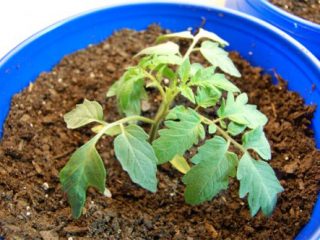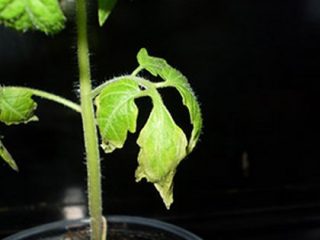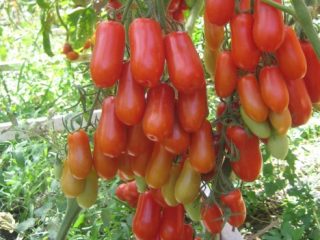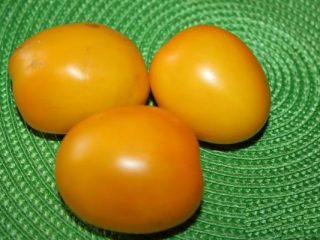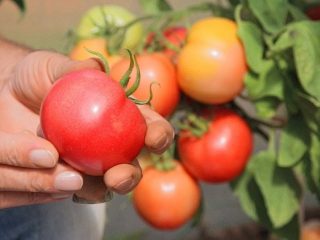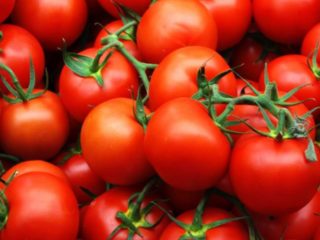Content
When choosing tomato seeds, every gardener wants to purchase an unpretentious, but guaranteed productive plant. Tomato Golden Mile F1 is quite often chosen for planting. This is an early ripening hybrid with tasty fruits, suitable for canning and fresh consumption.
History of appearance
The Golden Mile tomato can be called a young variety. This is a domestically selected crop, adapted to the conditions of most regions of the Russian Federation. The hybrid was bred by breeder V.I. Blokin-Mechtalin, general director of the Partner agricultural company. The application to the state register of selection achievements was submitted in 2019. Approved for use relatively recently. But he has already managed to win the love of summer residents.

The seeds of this hybrid are produced only by the Partner company.
Description and characteristics of tomato Golden Mile
The Golden Mile tomato is determinate, low-growing, early-ripening.
Description of the plant:
- The bushes are compact, up to 1 m high.
- The foliage is average.The leaves are of normal size and grayish-green in color.
- The flowers are bright yellow, collected in simple inflorescences. The plant lays its first flower cluster above the 6-7th leaf. Then, every two leaves, further flowers are formed. The brushes are simple. Each contains from 5 to 7 fruits.
- Tomatoes in the formation phase are green without a spot at the stalk, in technical ripeness they have a beautiful yellow-orange color, hence the name “Golden Mile”. The shape is round, slightly ribbed, with a small nose. The cut of the fruit has 3 or 4 chambers. The walls are thick and dense. But when eating, the skin is practically not felt.
- The pulp is juicy, there are few seeds. The taste is pleasant, balanced, rich, outstanding. Moderately sweet with a slight sourness. Fruits are in clusters of the same size, even, 200-220 g each. Thanks to the thick skin, the fruits can be stored for more than two weeks. Transportability is good.
When it ripens
LSL-type hybrid, early ripening. Golden Mile tomatoes on the bush ripen 95-100 days after emergence. When sowing seeds in early April, the first harvest can be obtained by mid-July. The Golden Mile variety is valued for its good fruit set and uniform ripening of clusters.
Tomato yield Golden Mile
In open ground, from 1 sq.m you can get a harvest of up to 20 kg, in closed ground - 5 kg more. One bush can produce up to 12 kg of delicious tomatoes.
Resistance to adverse factors
Golden Mile tomatoes are resistant to adverse weather conditions. If the requirements of agricultural technology are met, the bushes are not prone to late blight, bacterial wilt, tobacco mosaic virus, and brown spot.
Where is it grown?
Seedlings can be planted both in open ground and under film covers or in greenhouses.It can be grown indoors in all regions of our country: Northern, Northwestern, Central, Volga-Vyatka, Ural, West Siberian, Far Eastern and others.
Purpose and application
According to gardeners, the Golden Mile produces very tasty tomatoes. They are used fresh in salads and slices.

Juice and sauces are prepared from Golden Mile tomatoes
Small fruits are suitable for pickling and whole-fruit canning. Canned golden fruits look especially attractive and appetizing.
Advantages and disadvantages
The Golden Mile variety is in demand due to the unusual color of the fruits and their pleasant taste. Tomato has both advantages and disadvantages, which should be familiarized with before planting seedlings.

Golden Mile - a beautiful and quite fertile hybrid tomato
Pros:
- resistance to various diseases;
- compact size;
- unusual shape and bright color of the fruit;
- universal purpose;
- amicable maturation;
- excellent taste;
- good transportability;
- can grow both in open ground and in greenhouses.
Minuses:
- expensive planting material;
- seeds must be purchased annually.
How to plant correctly
Seeds should only be purchased in their original packaging in trusted stores, then you can be sure that you won’t come across a fake one. It is not worth sowing them for seedlings too early; the plant will stretch out and bloom. The transplant will be painful; the bush will take longer to adapt to new conditions. It is necessary to count approximately 60 days before the intended planting in the ground or in a greenhouse.
It is better to purchase ready-made soil for tomatoes and peppers; it is already balanced and composed in the required proportions. How the seedlings will grow depends on the correct soil. The first shoots appear on days 3-7. When true leaves appear, the seedlings are planted in separate containers with a volume of 0.7 - 1 liter. Fill the pot or container with soil up to the middle and plant a sprout. As the plant grows, soil is added. This is how the plant forms additional roots. A good root system means a healthy plant.
After the threat of return morning frosts, seedlings are planted in open ground. Choose a sunny place. The bed should be prepared in the fall. It would be good if legumes, carrots, and onions grew in this area last season.
Seedlings are planted in a greenhouse two weeks earlier than in open ground. The planting pattern in both cases is 50x50 cm, resulting in 3 or 4 bushes per 1 sq.m. The planted seedlings should be shaded for a while and covered from the scorching rays of the sun with non-woven material.
Features of care
Form a plant into two to three stems. They take stepson all the time. The lower leaves are removed before the first cluster is formed. Many tomato diseases live in the soil. If the lower leaves reach the ground, infection will occur faster. For the same purpose, it is better to tie the plant to a support. Once the fruits begin to turn yellow, the feeding leaf above them can be removed.
You can water tomatoes only in the evening after sunset or early in the morning. Moisten the soil only with warm water in the root circles.
Classic feedings. Seedlings need nitrogen to grow.To prevent plants from stretching, use potassium monophosphate. During flowering, the plant needs boron. During the period of fruit filling, potassium humate is introduced.
Loosen the soil carefully so as not to damage the root system. Weeding is necessary regularly. Ripe fruits are removed in a timely manner to speed up the ripening of other tomatoes.
Treatment against diseases and pests
When planting, you can use “Epin”, it will improve the adaptive abilities of the plant. For the prevention and treatment of fungal diseases, fungicidal preparations are used, for example, copper oxychloride, Fitosporin, Oxychom. To strengthen a diseased plant, you can combine spraying with fungicides with the use of complex water-soluble fertilizers and chelates. Small tomatoes sometimes develop blossom end rot. The disease is treated with calcium nitrate.
Tobacco dust will help against pests such as aphids, cutworms, and whiteflies. If there are too many insects, you can resort to chemical help. The drugs Cytcor, Phosbescide and others will help.
Conclusion
Golden Mile tomatoes are unpretentious, productive, and resistant to many diseases. The bushes are compact and low. Care consists of watering, weeding, fertilizing and shaping. They can grow in open ground, in greenhouses. Productivity is high. The tomatoes are delicious.

